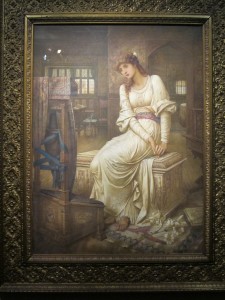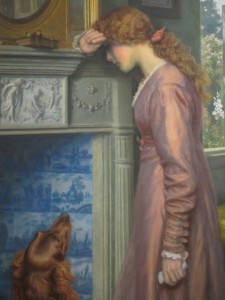An ancient palace – the Musée Jacquemart André – in Paris is currently showing romantic paintings from the Victorian era. The tenderly and poetically portrayed women might seem a bit passé in our modern times but how was that art-form perceived during those days? That’s a discovery that might come as a surprise to some visitors.
Sir Lawrence Alma-Tadema
Désirs et Volupté:
“Desire and voluptuousness” is the title of this exhibition that’s shown until January 20, 2014. Some 50 works of art, painted by the most famous English artists of the 19th century, among whom Sir Lawrence Alma-Tadema, Lord Leighton, Sir Edward Coley Burne-Jones and Albert J. Moore, illustrate the beauty ideal of the time. The paintings – belonging to Pérez Simón – are part of one of the most famous private collections dating from 1860 until the beginning of WWI.
England during the Victorian era (1837-1901) underwent important social and economical changes. The artists expressed their sensitivity during this puritanical epoch with paintings that contrasted with society’s strict moral codes and insensitivity. To protest they used the mysticism of antiquity and an expressive poetic symbolism with sensual portraits in focus.
They put aesthetics and beauty at the forefront: it became a life form. The movement called itself “the aesthetic movement” or the ”Pre-Raphaelite Brotherhood” with the woman as their main model. Her naked and lustful body symbolizes the repressed desire that the Victorian morality forbade their inhabitants to show and whose women were clad in long, dark, high-necked dresses with their hair put up in tight buns.
As a contrast the paintings have a dreamlike character with as background magnificent palaces with flourishing nature where sensual, libidinous, loving, half-naked women thrive in a dream-like atmosphere. Through their different models set in antique or medieval times, the painters expressed their nostalgia for a golden age.
John W. Waterhouse
In France, art was then totally different from in England, with the Impressionists who made their entrance. The French critics were absorbed by the artistic revolution happening in their country with Monet at its head. Thus the English romantics who’d already painted in the same style for years weren’t of great interest to them. On the other hand the English weren’t interested in the Impressionists. It is therefore especially fascinating for a Parisian public to discover these English artists. It’s the first time such an exhibition is shown in Paris, organized in themes.
William C. Wontner
Antiquity:
The first room of the exhibition displays the emblematic figure: Lawrence Alma-Tadema (1836-1912). He originated from Holland but moved to London in 1870 where he quickly became famous and ennobled. His perfect rendering of marble and its nervure or the transparency of alabaster as well as his compositions and technological dexterity were highly admired. He painted smaller paintings for the bourgeoisie and larger ones for the wealthier ones.
He painted the antique world, especially Pompeii. The best works were bought by the British Museum and Alma-Tadema soon became the collectors’ favourite.
Classical beauty:
Leaving the Greek-Roman times, the visitor discovers ancient Egypt in the adjacent room, through the romantic and biblical works of Frederick Goodall.
His colleague Frederic Leighton, inspired by Ingres and the European academic style, painted in a sculptural fashion. Albert J. Moore was more interested in decorative art and defended “art for the sake of art”. His harmonic paintings reminded me of musical notations.
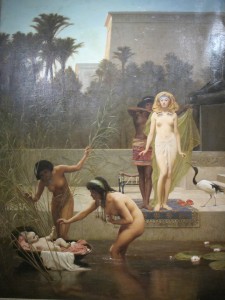
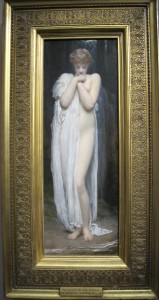
Muse:
Despite those artists’ fondness of antiquity most of them used live models. Burne-Jones was inspired by the typical English-look of women with red hair, white skin and long silhouettes. “Pygmalion” painted in several examples embodies the woman, the model and the fantasy. However women can be just as sensual and tender as cruel and false as shown by John William Waterhouse inspired by Shakespeare.
In England as in France, the Middle Ages – with heroines in love – are fashionable in the literature of the 19th century and that influence is also expressed in the paintings.
Harmony:
Another artist worth mentioning is Strudwick whose personal and technical style made me think of the renaissance period. His richness of details, especially in his draperies and refined accessories with rich and deep colours full of harmonious nuances, made him an appreciated and sought after artist. However, he, as well as most other artists in his vein, has been long forgotten, only to re-emerge thanks to this incredible collection.
Melancholy, unhappy love, longing … were recurrent themes for these artists who associated poetry with painting thanks to the inspiration they got from the literature as suggested by several of the paintings’ titles.
John Strudwick
Just as Nelson Mandela was inspired by Victorian poems while in prison. In homage of him, I’d like to cite this one:
Invictus by William Ernest Henley:
Out of the night that covers me,
Black as the pit from pole to pole,
I thank whatever gods may be
For my unconquerable soul.
In the fell clutch of circumstance
I have not winced nor cried aloud.
Under the bludgeonings of chance
My head is bloody, but unbowed.
Beyond this place of wrath and tears
Looms but the horror of the shade,
And yet the menace of the years
Finds and shall find me unafraid.
It matters not how strait the gate,
How charged with punishments the scroll,
I am the master of my fate:
I am the captain of my soul.
Women’s portrayal varies from romanticized antique, medieval legends and British charm but all of them pay homage to the beauty of women. These artists embody the Victorian dream in a thousand different ways.
The War put a stop to this aesthetic dream and the artists were forgotten for half a century but thanks to collectors like Pérez Simón and with this exhibition Parisians can finally take part in this passionate and romantic English art.
Now we also live in harsh times and we may need some old-fashion romanticism and an inspiring Victorian poem to keep us warm during the cold winter-months.
Anne Edelstam, Paris



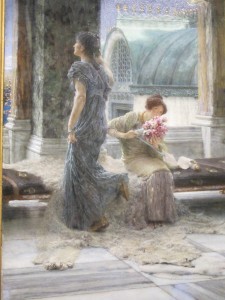

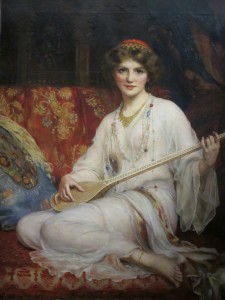
 John
John 
